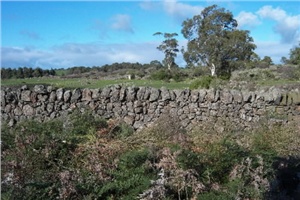Thousands of hectares of rock-strewn land between Camperdown and Colac has been transformed into prime grazing land in the last three years by a private contractor using a heavy bulldozer, vibrating compactor and roller. UNESCO's recognition of the area as part of Kanawinka Geopark chairwoman Joane McKnight said the crushing of rock in the Stony Rises had been a great concern.

Rock-strewn land between Colac and Camperdown
is typical of that being transformed by the power of
specialised earthmoving and rock-crushing equipment SCIENTISTS have called on the State Government to protect landmark volcanic features in the Stony Rises as rock crushers continue their sweep of the district.
"It frightens me because there's a whole area there that could be lost," Ms McKnight said yesterday.
"That is a very unique habitat right through there - not just geologically but also for its vegetation."
While it was a farmer's right to improve their land for agricultural production, Ms McKnight said some consideration should be given to setting an area of Stony Rises land aside for conservation and educational purposes as a "compromise".
University of Melbourne geologist Professor Bernie Joyce said further research was needed to identify lava flows in the Western District that could be "adversely affected" by crushing, rolling and raking with heavy machinery.
Professor Joyce, who is a member of the Geological Society of Australia and on the National Trust's state landscape committee, said rock crushing was only a recent threat to
He said the focus in past years had been on protecting the district's eruption points from inappropriate development such as quarrying, building of houses and overplanting.
"The other one (crushing) has sneaked up on us a bit," Professor Joyce admitted.
The National Trust has listed the Stony Rises area as being of national significance, containing important remnant vegetation and fauna.
"The difficulty in farming the rocky terrain has allowed the survival of vegetation communities which have been cleared from the more easily cultivated soils found elsewhere in the Western District," the trust states.
Professor Joyce said the trust had also conducted a more recent study of the
Professor Joyce said under existing legislation Heritage
This was different to
Premier John Brumby said although protection of the rises was a local government issue he was prepared to act on community concern.
"We need to protect these areas while allowing the reasonable use of surrounding areas for agriculture," Mr Brumby said.
"'If there was a feeling that some action was warranted, the Government would encourage a report (be) made to the council so that action warranted could be taken."